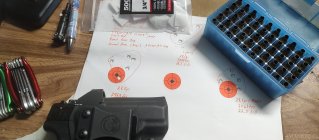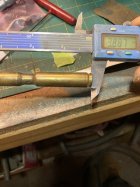So anyone ever noticed a big difference in group sizes when it comes to more or less should bump ? Long story short I lost my head space gauge and I got all this fire formed brass now .. would really like to make sure I'm only bumping .003-.005 like usual but without it ( next daying a new set, after ripping my house apart) it .....
So how much of a difference have y'all seen should bumping make in group size ? Enough that it's gonna be some major reworking when I'm able to measure again or SHOULD I be able to keep 1 MOA or so ?

So anyone ever noticed a big difference in group sizes when it comes to more or less should bump ? Long story short I lost my head space gauge and I got all this fire formed brass now .. would really like to make sure I'm only bumping .003-.005 like usual but without it ( next daying a new set, after ripping my house apart) it .....
So how much of a difference have y'all seen should bumping make in group size ? Enough that it's gonna be some major reworking when I'm able to measure again or SHOULD I be able to keep 1 MOA or so ?
View attachment 1709100
I haven't found that how much I bump makes much difference in group size and you should be able to keep 1MOA easy enough. Though bumping .003 to .005 can shorten the life of your brass by quite a bit . . . if that's any concern to you. In a non-hunting bolt gun going with .002 or less bump can help with good consistency.
I haven't found that how much I bump makes much difference in group size and you should be able to keep 1MOA easy enough. Though bumping .003 to .005 can shorten the life of your brass by quite a bit . . . if that's any concern to you. In a non-hunting bolt gun going with .002 or less bump can help with good consistency.
Ok cool to hear . And yeah but also when I've measured it sided buy what the instructions say I was bumping back like 10 to 15 thou

Also in these are goin in my gas gun ..that along with the fact I'm usually dropping round on the ground alot, better safe then sorry I think lol ! Seriously though I tried only doing .001 and man was nothing but problems, probably has to do with my lower cost gear just not being able to measure as precisely ..... Or my guns just being dirty more then they should be
Welp guess I'll go ahead and resize all these and try to do the ole "feel method"
I never did a controlled test regarding the degree of bump versus accuracy since this issue is irrelevant to optimum F/L sizing of the cases. Let me explain.
The purpose that I F/L size with a controlled degree of bump is so that I obtain optimum fit of the case for a specific rifle chamber. Optimum fit meaning sizing for reliable chambering without over sizing the case.
The only thing close to this issue that I can comment on is many years ago I neck size and when I converted to 100% optimum F/L sizing I did not detect any significant change in results on target.
Without a bump gauge, you could set your F/L die the old fashion way before the advent of bump gauges. Using the rifle chamber with the firing pin assembly remove and adjusting your F/L die to so the sized case chambers with very light to no resistance. This way, you can assure reliable chambering without over sizing the case.
Benchrest gun are run with no bump or .001 max. That should tell you something. But is it practical for other sport ? Probably not. Accuracy needed goes with what you need to accomplish.
.002 will get you brass life and all accuracy you can extract from bumping. There is way more to accuracy than case bump.
For my AR's, I've always set the shoulder back ~2 thousandths +/- a thousandth.
But, I also clean the chamber every 50 -100 shots - except for a few times where the shot count got to 150 - 200.
Personally, 5 thousandths is way more than needed.
For groups in the 3/4 MOA range, I have seen no impact on group size between rounds that are -3 to +3 thousandths to a go gauge. I don't think there is any impact on groups in the 1/2 MOA range.
So anyone ever noticed a big difference in group sizes when it comes to more or less should bump ? Long story short I lost my head space gauge and I got all this fire formed brass now .. would really like to make sure I'm only bumping .003-.005 like usual but without it ( next daying a new set, after ripping my house apart) it .....
So how much of a difference have y'all seen should bumping make in group size ? Enough that it's gonna be some major reworking when I'm able to measure again or SHOULD I be able to keep 1 MOA or so ?
View attachment 1709100
getcha a 9mm empty case
Insert it over the neck onto the shoulder and use that as a chamber gauge... measure OAL end to end
Compare this to one you know is of correct shoulder bump
The 9mm case hits a nice index spot on the shoulder of most LR cases
I don't have an empty 9mm case here at the shop but you get the idea.
I used to make chamber gauges, now all I use are 9mm and 10mm empty cases to gauge shoulder bump
if you have a bullet seated and need to double check - use the longer 38 special case
---
Have your required OAl written on the case you use as a tool, THAT CASE ONLY
dont just grab any emtpy case laying around as they all will be different lengths
use the same one
I have several with the numbers written on them for various calibers
-

IMG_5469.jpg
64.9 KB
· Views: 40
Jim McGregor
Silver $$ Contributor
Benchrest gun are run with no bump or .001 max.
I would suggest that there is no on target benefit to this approach. If anything it detracts from smooth operation and gun handling can suffer.
If you do the Wheeler method you might find .002 isn't enough for the bolt to drop without no resistance.
Eric Cortina shows on one of his videos it takes .004
Jim McGregor
Silver $$ Contributor
Well I’m not a big shot anything Here’s my target. For a nobody I say it’s beneficial
Neither am I. That is a fine group, but you could do the same without running that tight and potentially sacrificing gun operation. Been there, done that. I tested the theory and it was white noise for me. If it works for you have at it, but in the previous post made by
@Janeau he indicated that zero bump or .001 bump is the norm for BR. I say that is not the case at all. There are no absolutes in this stuff and there are better ways if people do the testing for themselves to see what matters and what does not matter.
Since we are posting targets to prove a point, here are four consecutive match targets with .003 bump. Not a single tight chambering round in the bunch. Did not give up anything.

100 yards is slingshot range...although I do boresight at 100. Bump from .0015 to .0025 never hurt a thing.
When using the TP 'Wheeler' method, it's good to pair it with checking the shoulder diameter change, as Tony Boyer shows in his book. That will show you why you sometimes need .004-.005 to feel like .002
should feel like.
Good shootin'

-Al
I don't like them targets . I think them were shot at 50 yards .

HAHA Good shooting Jim
Jim McGregor
Silver $$ Contributor
Someone will take that down too buddy. That is why they keep track. Hope you are good Brad.
When using the TP 'Wheeler' method, it's good to pair it with checking the shoulder diameter change, as Tony Boyer shows in his book. That will show you why you sometimes need .004-.005 to feel like .002
should feel like.
Good shootin'

-Al
I’ve also discovered the same to be true at the case head. I had to adjust my Redding 6BR body die downward to properly size near the case head and that resulted in over 0.006” headspace. Led me to buying a set of Harrell’s dies that have varying diameters to size the case head and set the desired headspace.
Its why die- chamber fit is important.
I guess my point was to dont just assume .002 is gonna give you what your after.
Not a democrat
Silver $$ Contributor
In my personal experience it’s not about how much or how little it’s about consistency that shows up at distance in regards to shoulder bumping. Obviously excessive bumping is going to reduce brass life and cause other problems. Not enough is a good way to gall lugs and be annoying and unreliable.
That advice is worth what you paid for it, but it’s my story!
I typically bump my shoulders .002 on my BA hunting rifles. I’ll bump it and try it in the rifle before assuming that .002 is gonna give me what I want.
To answer your question though, I’ve never really compared groups with various shoulder bumps.
This may or may not help make life easier. I use SAC should bump kit for most of my rifles (expensive but accurate) but I keep a spare kit for measuring shoulder bump for new rifles I don’t have a SAC insert for. Link below, it comes in handy often and I like much better than the Hornady kit.
I have simplified my AR brass sizing by using an ammo checker for setting the sizing die. My winter hunting ammo must drop in to the lower step minimum (0.001 below the step is my target). I don't want ANY loading/unloading live round issues, especially critical when temps are below zero(and at night). I have not had any issues with brass life/separation and I have started to use that die setting for my bolt gun ammo too(mostly prairie dog ammo) for 3 different rifles. When I drop check new brass in the ammo checker(Lyman) all have been several thousands below the lower step and with a comparator are 0.005+ shorter than my sized brass. My KISS and reliable method.
To much resistance will throw flyers i know that for a fact I've had it done to me more than once, how much is to much I dont know all I can tell you is since I've started the Wheeler method it ain't happening.














